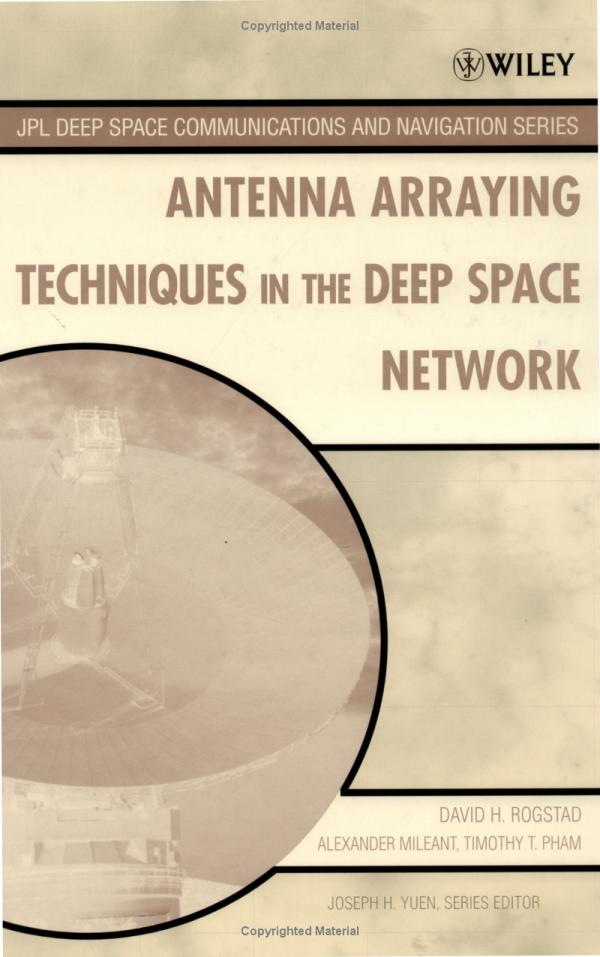
Antenna Arraying Techniques
in the Deep Space Network
David H. Rogstad
Alexander Mileant
Timothy T. Pham
MONOGRAPH 5
DEEP SPACE COMMUNICATIONS AND NAVIGATION SERIES
DEEP SPACE COMMUNICATIONS AND NAVIGATION SERIES
Issued by the Deep Space Communications and Navigation Systems
Center of Excellence
Jet Propulsion Laboratory
California Institute of Technology
Joseph H. Yuen, Editor-in-Chief
Previously Published Monographs in this Series
1. Radiometric Tracking Techniques for Deep-Space Navigation
C. L. Thornton and J. S. Border
2. Formulation for Observed and Computed Values of
Deep Space Network Data Types for Navigation
Theodore D. Moyer
3. Bandwidth-Efficient Digital Modulation with Application
to Deep-Space Communications
Marvin K. Simon
4. Large Antennas of the Deep Space Network
William A. Imbriale
Antenna Arraying Techniques in the Deep Space Network
(JPL Publication 03-001)
January 2003
The research described in this publication was carried out at the
Jet Propulsion Laboratory, California Institute of Technology, under
a contract with the National Aeronautics and Space Administration.
Reference herein to any specific commercial product, process, or service
by trade name, trademark, manufacturer, or otherwise, does not constitute
or imply its endorsement by the United States Government or the
Jet Propulsion Laboratory, California Institute of Technology.
Table of Contents
Foreword.................................................................................................................ix
Preface.....................................................................................................................xi
Acknowledgments..................................................................................................xiii
Chapter 1: Introduction....................................................................................1
1.1 Benefits of Arraying ...................................................................2
1.1.1 Performance Benefits......................................................2
1.1.2 Operability Benefits ........................................................3
1.1.3 Cost Benefits ...................................................................3
1.1.4 Flexibility Benefits..........................................................4
1.1.5 Science Benefits .............................................................4
References.............................................................................................4
Chapter 2: Background of Arraying in the Deep Space Network ......7
2.1 Early Development......................................................................8
2.2 Current Status of Development ..............................................9
2.3 Anticipated Applications with Current Capabilities .......11
References...........................................................................................12
Chapter 3: Arraying Concepts .....................................................................13
3.1 An Array as an Interferometer...............................................13
3.2 Detectability ................................................................................16
3.3 Gain Limits for an Antenna and Array................................17
3.4 System Temperature................................................................18
3.5 Reliability and Availability......................................................20
References...........................................................................................24
Chapter 4: Overview of Arraying Techniques.........................................25
4.1 Full-Spectrum Combining (FSC) ..........................................26
vi
4.2 Complex-Symbol Combining (CSC)....................................27
4.3 Symbol-Stream Combining (SSC)........................................28
4.4 Baseband Combining (BC).....................................................29
4.5 Carrier Arraying (CA) ...............................................................30
References...........................................................................................31
Chapter 5: Single-Receiver Performance.................................................33
5.1 Basic Equations.........................................................................33
5.2 Degradation and Loss .............................................................35
References...........................................................................................40
Chapter 6: Arraying Techniques .................................................................43
6.1 Full-Spectrum Combining (FSC) ..........................................44
6.1.1 Telemetry Performance.................................................49
6.2 Complex-Symbol Combining (CSC)....................................54
6.2.1 Telemetry Performance.................................................58
6.3 Symbol-Stream Combining (SSC)........................................59
6.4 Baseband Combining (BC).....................................................61
6.5 Carrier Arraying (CA) ...............................................................65
6.5.1 Baseband Carrier-Arraying Scheme.............................67
6.5.2 IF Carrier-Arraying Scheme .........................................68
References...........................................................................................71
Chapter 7: Arraying Combinations and Comparisons.........................73
7.1 Arraying Combinations ...........................................................73
7.2 Numerical Examples ................................................................76
7.2.1 Pioneer 10......................................................................76
7.2.2 Voyager II......................................................................77
7.2.3 Magellan........................................................................81
7.2.4 Galileo ...........................................................................81
7.3 Conclusions................................................................................91
Reference .............................................................................................92
Table of Contents vii
Chapter 8: Correlation Algorithms .............................................................93
8.1 General .........................................................................................93
8.2 Simple...........................................................................................94
8.3 Sumple..........................................................................................94
8.4 Eigen .............................................................................................96
8.5 Least-Squares ............................................................................96
8.6 Simulations .................................................................................96
References...........................................................................................97
Chapter 9: Current Arraying Capability ....................................................99
9.1 Equipment Description..........................................................100
9.2 Signal Processing...................................................................101
9.2.1 Correlation...................................................................102
9.2.2 Delay Compensation ...................................................105
9.2.3 Combining...................................................................106
9.3 Results........................................................................................106
9.3.1 Telemetry Array Gain .................................................106
9.3.2 Radio Metric Array Gain ............................................107
References.........................................................................................109
Chapter 10: Future Development..............................................................111
10.1 The Square Kilometer Array...............................................112
10.2 The Allen Telescope Array .................................................114
10.3 The DSN Large Array............................................................115
10.3.1 Correlation...................................................................120
10.3.2 Monitor and Control....................................................121
10.3.3 Signal Distribution ......................................................121
10.3.4 Maintenance ................................................................121
10.3.5 Data Routing................................................................122
10.4 The Uplink Array....................................................................122
10.4.1 Electronic Stability......................................................123
viii
10.4.2 Tropospheric Variation ...............................................123
10.5 Software Combiner ...............................................................124
10.6 Final Remarks.........................................................................124
References.........................................................................................125
Appendix A: Antenna Location .................................................................127
Appendix B: Array Availability...................................................................131
Appendix C: Demodulation Process........................................................133
C.1 Signal Model .............................................................................133
C.2 Carrier Demodulation.............................................................134
C.3 Subcarrier Demodulation......................................................134
C.4 Symbol Demodulation ...........................................................135
Appendix D: Gamma Factors for DSN Antennas.................................137
Appendix E: Closed-Loop Performance.................................................139
Appendix F: Subcarrier and Symbol-Loop SNR Performance .......141
F.1 Subcarrier I- and IQ-Loops...................................................141
F.2 Digital Data-Transition Tracking I- and IQ-Loops .........144
Appendix G: Derivation of Equations for Complex-Symbol
Combining ...........................................................................................151
G.1 Derivation of Eq. (6.2-5).........................................................151
G.2 Derivation of Eq. (6.2-11) ......................................................152
General Reference List..................................................................................153
Acronyms and Abbreviations......................................................................161
Foreword
The Deep Space Communications and Navigation Systems Center of
Excellence (DESCANSO) was established in 1998 by the National Aeronautics
and Space Administration (NASA) at the California Institute of Technology’s
Jet Propulsion Laboratory (JPL). DESCANSO is chartered to harness and
promote excellence and innovation to meet the communications and navigation
needs of future deep-space exploration.
DESCANSO’s vision is to achieve continuous communications and precise
navigation—any time, anywhere. In support of that vision, DESCANSO aims
to seek out and advocate new concepts, systems, and technologies; foster key
technical talents; and sponsor seminars, workshops, and symposia to facilitate
interaction and idea exchange.
The Deep Space Communications and Navigation Series, authored by
scientists and engineers with many years of experience in their respective
fields, lays a foundation for innovation by communicating state-of-the-art
knowledge in key technologies. The series also captures fundamental principles
and practices developed during decades of deep-space exploration at JPL. In
addition, it celebrates successes and imparts lessons learned. Finally, the series
will serve to guide a new generation of scientists and engineers.
Joseph H. Yuen
DESCANSO Leader

